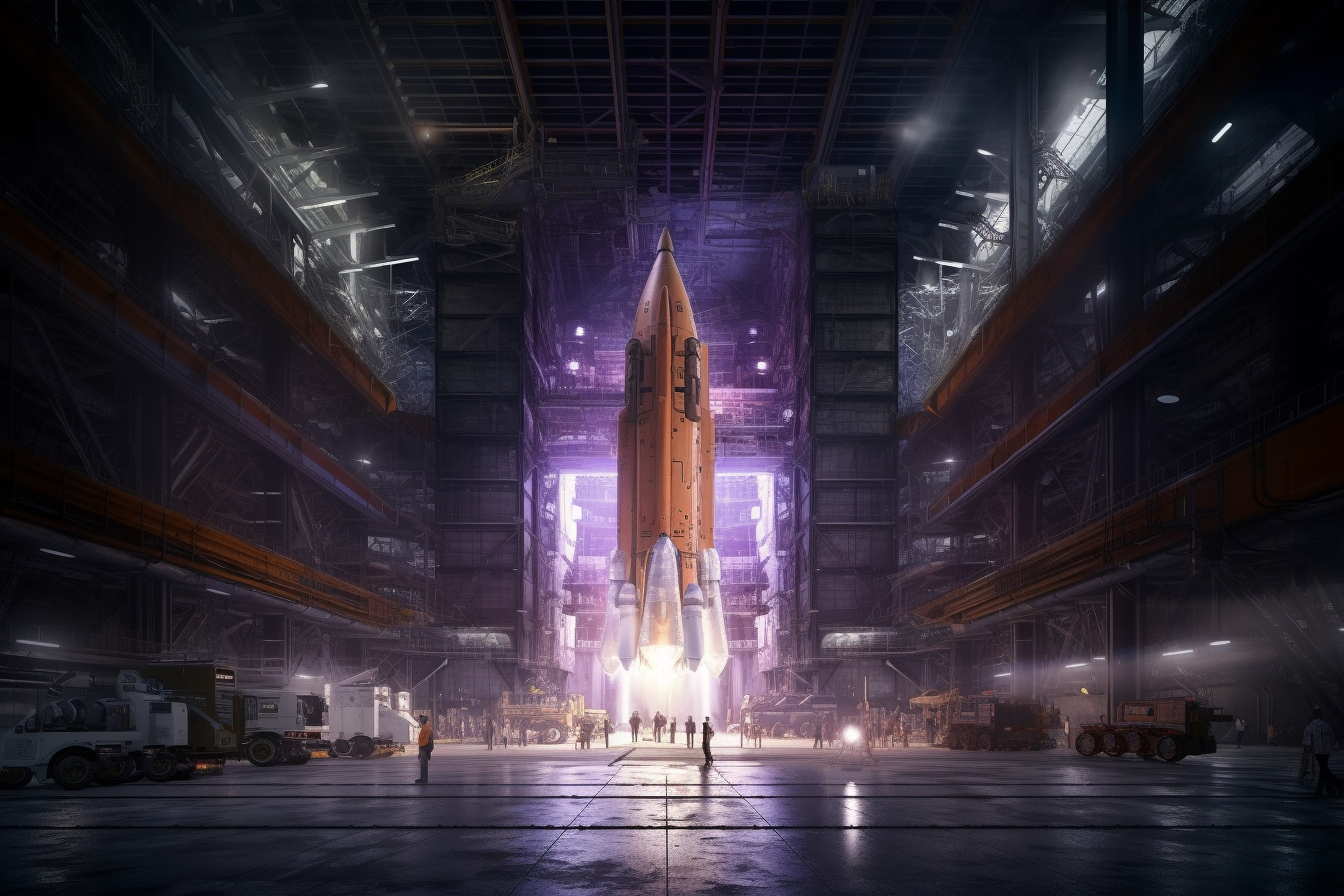by Harald Köpping Athanasopoulos

In the first half of 2023 I conducted a study on the future of the global space economy for the future studies institute 2b AHEAD. Being based on in-depth expert interviews from both inside and outside the space sector, the study contains some wild predictions for the upcoming two decades: private space stations, modular, repairable satellites, a permanent Moon base, and nuclear propulsion. But many of these predictions stand on the assumption that SpaceX’s Starship will, as promised, dramatically ease accessibility to space. What if Starship fails? In this article, I would like to provide an overview of the consequences of Starship’s failure for future human activities in space.
Even if you don’t much care for space exploration, you will have to admit that Starship is a technological marvel. If successful, it would undoubtedly be the most powerful rocket ever flown. Access to space would become more affordable. Estimates predict that launch costs per kilogram to LEO might drop to $200, which is an order of magnitude less than the Falcon Heavy’s $2,350. The consequences of this drop are enormous. Currently, spacecraft manufacturing depends on great levels of precision and intensive testing, because the loss of a spacecraft is prohibitively expensive. If launch costs were to drop to the levels foreseen, spacecraft could achieve higher levels of expendability, which in turn reduces manufacturing costs. This impact of Starship would eventually trickle down through the entire industry, causing cost reductions across the board. However, lower price tags are only one opportunity presented by Starship. The enormous rocket possesses enough volume to transport a whole house to space, enabling far more complex satellites and the construction of infrastructure on the lunar surface. The first launch, which took place a few weeks after the study was completed, ended in failure. Since then, more items are added to a list of problems and some are beginning to compare Starship to the ill-fated Soviet N1, which also relied on a complex engine configuration. So what would happen to humanity’s future in space if Starship fails?
Consequences of Starship’s failure
Several technologies and infrastructures would – at least – be significantly delayed if Starship fails to become operational. Many experts who participated in the study predicted that by 2040, it would become possible to repair satellites in orbit and to ‘retrofit’ them with new or additional hardware. Currently, most satellites are simply discarded or deorbited once their lifespan is complete. It is significantly cheaper to construct a replacement satellite on earth and to send it into orbit, than to attempt a repair operation. Lower launch costs and fewer volumetric restrictions could enable the economic feasibility of MRO in LEO. If Starship fails, the widespread implementation of such endeavours would likely remain science fiction.
Starship’s failure would therefore stand for the failure of SpaceX to deliver on its promises.
The widespread availability of private space stations is another prediction made by many of the experts who participated in the study. The need for private space stations is driven by commercial demand for micro-gravity laboratories, where companies are attempting to investigate the feasibility of space manufacturing. While Axiom will likely launch its private space station in the near future, the failure of Starship would cast doubt on the viability of private space stations for commercial actors that have hitherto remained outside the space section, such as pharmaceuticals.
A third major prediction for the future of space until 2040 that would be impacted by Starship’s failure concerns the establishment of a permanent Moon base. Although no concrete plans to build a lunar outpost currently exist, the Artemis programme intends to return humans to the Moon by in the latter half of this decade. Starship represents a vital part of the Artemis mission architecture, as NASA’s plans foresee it being used as a lunar lander. Being aware of the risk involved in placing all its bets on a single privately built system, NASA has selected Blue Origin as a second lunar lander provider. By the time Blue Origin’s lander is ready, perhaps in the early 2030s, it is doubtful whether the political climate in the United States will still be in favour of a return of astronauts to the Moon, with the programme by then having swallowed billions without producing results. Even if Artemis were to proceed with Blue Origin’s human landing system, a lunar outpost is unlikely to be functional by 2040, given those significant delays.
Apart from these concrete consequences, Starship’s failure would also tarnish the reputation of SpaceX, which has already suffered from Elon Musk’s mismanagement of Twitter and his polarising political statements. SpaceX has managed to become one of the world’s most well-known space actors and arguably it has inspired renewed interest in space exploration. Starship’s failure would therefore stand for the failure of SpaceX to deliver on its promises, which in turn could curb enthusiasm across the entire space ecosystem.
The end of the space renaissance?
While Starship’s failure would undoubtedly represent a severe blow to the future growth of the global space economy, many of the predictions made in the study would likely still be realised because they do not depend on a reusable megalauncher. One scenario that was mentioned by the majority of the experts who participated in the study is that traditional spacecraft propulsion systems will be complemented by nuclear-powered propulsion systems. There are two types of nuclear propulsion, namely nuclear thermal propulsion (NTP) and nuclear electric propulsion (NEP). NTP involves using a nuclear reactor to heat a propellant, whose expansion can then be used to give thrust to a spacecraft. For NEP, the nuclear reactor is used to generate electricity, which is then used to power an electric thruster such as an ion engine or plasma thruster. In 2040, both types of propulsion will likely be available for commercial, military, and scientific applications. While NTP is especially useful for spacecraft with a high frequency of manoeuvres (high thrust, short duration), NEP is most appropriate for spacecraft with a focus on durability (low thrust, long duration). There are countless applications for spacecraft equipped with nuclear propulsion engines, such as raw material scouting of the asteroid belt or long-duration earth observation missions. Nuclear electric propulsion will provide a new impetus for human activities on the Moon and beyond, which will become significantly more feasible.
Starship represents a vital part of the Artemis mission architecture.
A second technological revolution that has already begun and which does not depend on the availability of Starship is the establishment of megaconstellations. SpaceX and OneWeb are currently establishing systems which will provide global internet coverage. In the near term future, customers will need to pay to subscribe to these services. During the 2030s, it is likely that the services themselves become free, while providers use alternative business models for profit generation, such as higher bandwidth services for commercial clients or data access. Global, free internet coverage may allow leapfrogging for developing countries, which no longer need to invest in expensive duplicate infrastructures. Moreover, there is no reason to assume that the use cases of satellite megaconstellations will be limited to providing global internet access. Satellites in megaconstellations could also be equipped with cameras and other earth observation systems, providing real-time data for the construction sector, agriculture, governments, and earth science. The widespread availability of real-time data from space is a critical feature of the future of the space economy and it does not depend on Starship.
From a scientific perspective, the failure of Starship would of course be unfortunate, especially due to its impact on the Artemis programme, which would at least be significantly delayed. However, Starship plays no role in what is often described as the holy grail of planetary science: Mars sample return. While robotically operated laboratories on Mars rovers have produced incredible insights into the Red Planet’s ancient past, these insights will be spectacularly surpassed by analysing Mars regolith samples in humanity’s best labs. Other missions that are unaffected by Starship include missions to the Jovian system, including ESA’s JUICE mission to Jupiter’s moon Ganymede and NASA’s Europa Clipper. Both missions are aimed at revealing the nature of the water oceans hidden underneath the surfaces of those moons. Exoplanet detectors such as ESO’s Extremely Large Telescope and ESA’s PLATO telescope will grant new perspectives into the question of how rare Earth really is, and of whether the conditions suitable for the emergence of life are widespread. The failure of Starship would however delay ambitions to conduct radio astronomy on the far side of the Moon, where telescopes could theoretically be constructed that are far more sensitive than earth-based radio telescopes.
Conclusion: Significant delays, but not the end of everything
While Starship’s failure would represent a huge blow to humanity’s aspirations in space, many if not most aspects of the future of space I had depicted in the study would still take place. Nuclear propulsion, megaconstellations, Mars sample return, exoplanet detectors, and even some private space stations would still happen. Moreover, some interviewees that I talked to when I wrote the study spoke about potential alternatives to Starship that could be developed in the foreseeable future, particularly by China. SpaceX has at the very least produced a proof of concept that a reusable megalauncher is feasible. The space community has become aware of the tremendous impact such a launcher could have not just for the space economy but non-space companies around the world whose ideas related to space would become implementable.
If you would like to read through the whole study I just cited in this article, you can download it for free here.

Harald Köpping Athanasopoulos is a futurist at 2b AHEAD ThinkTank and space policy researcher at ESSCA School of Management. He studied International Relations, European Studies and Management Studies in Swansea, Maastricht and Liverpool, having completed his PhD in 2014. Harald is a long-standing member of the ESSCA space policy working group, having published extensively on the European space programme and the link between space policy and science fiction. At 2b AHEAD ThinkTank in Leipzig, Harald is investigating the future of humanity’s ambitions in space. As a public speaker Harald shares his optimism about the future and presents his vision of outer space as the final frontier.





